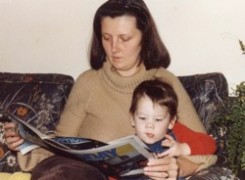Helping Kids Make Sense of Print
Can’t Tell the Players without a Program?
When learning anything new, you encounter many new special words. To learn to play baseball, players learn the meaning of baseball, bat, home plate, pitcher, umpire, and so many other words. Players and spectators must learn concepts, too, like foul ball or walk.
And beginner readers have to learn lots of vocabulary, too, words like letter, word, sound, sentence, paragraph, title, author, cover, and so forth. Clever parents and teachers will ensure children don’t even notice they’re learning this specialized jargon.
As they read book after book, adults will quietly, unobtrusively talk about the print. Consider how a beginning reader might learn that in books each printed word is separated by white spaces. Until readers know this, it is difficult for them to look at a particular word as an adult reads it aloud.
Talking about print in books can help children learn the concept of a printed word. Here’s how to do it. Find a book that ends with the words: The end. (You might print out a copy of Baby Faces from this website.)
Read the story in the usual way. But when you finish the story, start a little conversation about the final words on the page, the end. You don’t need to repeat these comments word-for-word. Just read through the demo dialog and start your own conversation. “Well, that’s the end of the book. Oh, look: The author wrote two words here so we would know for sure we finished reading the book: the end.” [Touch the page with your index finger just under each word each time as you say it.] “The end. There’s the first word: the. There’s the second word: end. The end. You can tell where the first word ends because there’s a little white space. Then the next word starts. That white space shows where the other word ends.” This is typical of many conversations that will help your emerging reader make sense of print, so make it fun.
Whether it’s feeding or dressing themselves, toddlers and preschoolers like to do things independently. That natural urge to be one’s own boss helps them learn to read, too. Many young children like to read books by themselves.
Not all children are like Dylan, who at nine months liked to lie on his back, hold a picture book over his head, and vocalize just as though he were reading aloud to himself. But many toddlers and preschoolers will sit with a picture book on the lap, recount the story aloud as they turn the pages, and insist they are “reading.” One of the easiest ways to encourage this give-it-a-go attitude toward reading is to draw the reader’s attention to the concepts and conventions of print. Don’t be surprised when, after your mini-lesson, your young emergent reader wants to do the reading every time you come to those magic words, The end. And helping children think about these words helps them become even more efficient at learning to read.
Sharing the journey to literacy can be as exciting as a trip through the Rockies. And it bonds the travelers like only a road trip can.
go to top
Whitehead, Marian. (2002). “Dylan’s Routes to Literacy: The First Three Years With Picture Books.” Journal of Early Childhood Literacy.” 2, 3, 269-89.

- What’s a letter?
- Why is there white space between words?
- Why is the text in chunks?